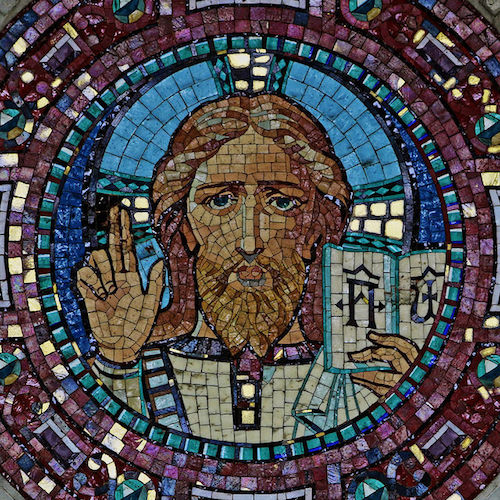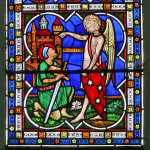We run our website the way we wished the whole internet worked: we provide high quality original content with no ads. We are funded solely by your direct support. Please consider supporting this project.

The Centrality of Christ in Hebrews, Part 1
The intense Christocentricity that the New Testament writers embrace is nowhere more clearly and consistently illustrated than in the book of Hebrews. Throughout this work we find a repeated emphasis on the many ways the revelation given to us in Christ surpasses that of the Old Testament. The author begins by stressing how the revelation of God in his own Son contrasts with and surpasses all previous revelations by virtue of the fact that the Son alone is the “radiance of God’s glory” and the “exact representation of his being” (Heb. 1:3). Consistent with this, the first ten chapters of this work are structured around Christ’s superiority:
- to angels, (1:5-2:18)
- to Moses (3:1-4:13)
- to the Aaronic Priesthood (4:4-7:28)
- to the High Priests and their sacrifices (chapters 8-10)
Reflecting this same perspective, the author sees the tabernacle erected by Moses to be a “copy” and “shadow” of the “true tabernacle set up by the Lord” (8:1-6). So too, the activity of the high priest on the day of the atonement in the OT was, for this author, the Holy Spirit’s way of “showing … that the way into the Most Holy Place had not yet been disclosed.” It thus serves as “an illustration (parabolē) for the present time” of the inferiority of the OT practices and the superiority of the sacrifice Christ makes and of the new covenant he brings (Heb. 9:8-28).
In the same way, the author of Hebrews held that “the law is only a shadow of the good things that are coming—not the realities themselves,” for the law could never “make perfect those who draw near to worship” (10:1). Only the sacrifice of Jesus—the reality to which the law and everything else in the OT points—can perfect people before God once and for all (10:10,14).
Given this perspective, we are hardly surprised to find this author discerning Christ in a wide array of OT passages. Let’s look at the opening chapter as a prime example. The author of Hebrews begins by interpreting the song that was sung at the coronation of a king (Ps. 2:7) to be a song about the enthronement of Christ (Heb 1:5). The author then goes on to demonstrate the superiority of Christ over angels by applying a reworked version of Psalm 104:4 to angels, showing them to be mere servants of Yahweh, while applying Psalm 45:6-7 to Christ, for this latter Psalm is a tribute to “God” whose “throne … will last forever and ever” (Heb 1:7-8).
And finally, to buttress Christ’s superiority over angels even further, this author goes on to apply to Christ a song about Yahweh’s work as Creator (Heb 1:10, cf. Ps 102:25-27). The circular way this author uses Scripture to prove Christ’s superiority simply reveals that he is approaching the OT with the assumption that it is a collection of works that is about Christ.
In the next post, we will explore a few more examples of how the writer of Hebrews puts Christ at the center of the Old Testament.
Photo credit: Leo Reynolds via Visual hunt / CC BY-NC-SA
Category: General
Tags: Bible Interpretation, Christocentrism, Cruciform Theology, New Testament, Old Testament
Topics: Christology
Related Reading

How Reliable were the Early Church’s Oral Traditions?
How reliable were the early church’s oral traditions? In terms of assessing the reliability of the Gospels, this is an extremely important question. First century Jewish culture was what scholars today would call an “orally dominated culture.” While a certain percentage of people could read and write (see below), information was for the most part…

A Dialogue with Derek Flood Part 2: Is ALL of the Bible Inspired?
Image by TheRevSteve via Flickr Yesterday, I offered the first part of my response to Flood’s comments regarding my review of his book. Today I’ll finish up my thoughts. Scripture and Its Interpretation Flood confesses that he is confused as to how I can claim that “in the light of Christ, we must reject violent interpretations of Scripture”…

Sin-Bearing God
On the cross, God became our sin, as Paul wrote: “God made him who had no sin to be sin for us” (2 Cor 5:21). However, God didn’t begin to be a sin-bearing God when Jesus walked the earth and hung on the cross. Rather he became Incarnate and bore our sins on the cross…

Podcast: If Sin has Its Own Consequences, What Does God Actually Forgive?
Greg talks forgiveness, reconciliation, consequences of sin, and the afterlife. All in less than 5 minutes. http://traffic.libsyn.com/askgregboyd/Episode_0346.mp3

The Jesus Seminar and the Reliability of the Gospels
The Jesus Seminar The primary driving force behind the popular media’s present preoccupation with liberal views of Jesus has been the Jesus Seminar. This Seminar, first convened in 1985 by Robert Funk, is a gathering of 100 or so mostly liberal New Testament scholars who meet on a regular basis. They have determined, by a…

Podcast: Is the Cruciform Hermeneutic a Little Too New?
Greg looks at the history of the Cruciform Hermeneutic. http://traffic.libsyn.com/askgregboyd/Episode_0446.mp3
